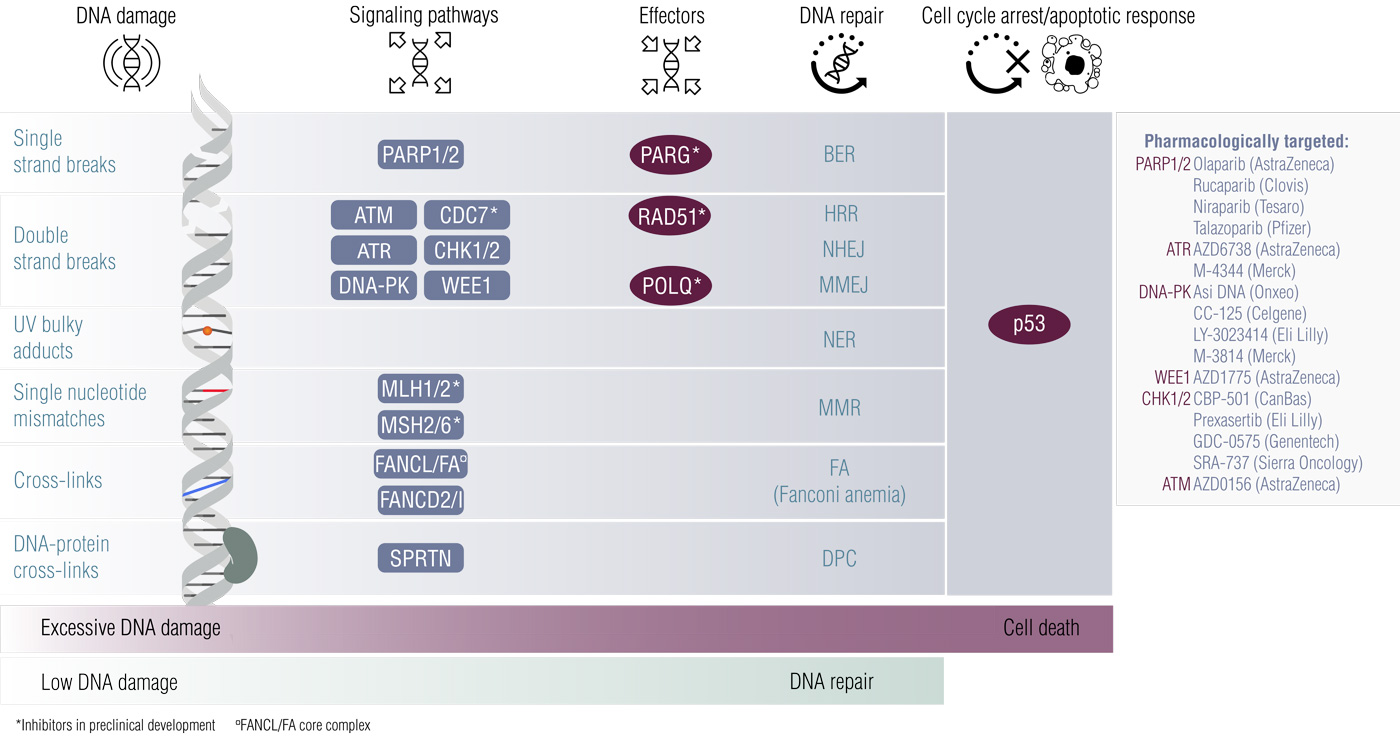Cells have evolved a number of pathways that comprise a network of proteins that sense, signal and/or repair DNA, which are collectively referred to as the DNA Damage Response (DDR; see figure 4) [1-5]. There are several hundred proteins implicated in the DDR. Key proteins that signal DNA damage to cell cycle checkpoints and DNA repair pathways include ATM (ataxia-telangiectasia mutated), ATR (ATM- and Rad3-related), and DNA-PKcs (DNA-dependent protein kinase, catalytic subunit) kinases [2, 6-9].
Once DNA damage is detected, repair mechanisms can include [1]:
- Base excision repair (BER) for single strand breaks.
- Nucleotide excision repair (NER) for repair of bulky adducts.
- Mismatch repair (MMR) for mis-paired bases.
- Homologous recombination repair (HRR) for double strand break repair.
- Non-homologous end joining (NHEJ) for double strand break repair.
- Micro-homology mediated end joining (MMEJ) for double strand break repair.
Cells with excessive or unrepairable DNA may enter cell cycle arrest and/or trigger apoptosis, a p53-dependent mechanism [3].
Figure 4: DNA damage repair (DDR) signalling pathways and repair mechanisms
References
- O'Connor MJ. Targeting the DNA Damage Response in Cancer. Mol Cell 2015; 60: 547-560.
- Pearl LH, Schierz AC, Ward SE et al. Therapeutic opportunities within the DNA damage response. Nat Rev Cancer 2015; 15: 166-180.
- Jackson SP, Bartek J. The DNA-damage response in human biology and disease. Nature 2009; 461: 1071-1078.
- Friedberg EC. A brief history of the DNA repair field. Cell Res 2008; 18: 3-7.
- Sancar A, Lindsey-Boltz LA, Unsal-Kacmaz K, Linn S. Molecular mechanisms of mammalian DNA repair and the DNA damage checkpoints. Annu Rev Biochem 2004; 73: 39-85.
- Corcoran NM, Clarkson MJ, Stuchbery R, Hovens CM. Molecular Pathways: Targeting DNA Repair Pathway Defects Enriched in Metastasis. Clin Cancer Res 2016; 22: 3132-3137.
- Marechal A, Zou L. DNA damage sensing by the ATM and ATR kinases. Cold Spring Harb Perspect Biol 2013; 5.
- Blackford AN, Jackson SP. ATM, ATR, and DNA-PK: The Trinity at the Heart of the DNA Damage Response. Mol Cell 2017; 66: 801-817.
- Harper JW, Elledge SJ. The DNA damage response: ten years after. Mol Cell 2007; 28: 739-745.

